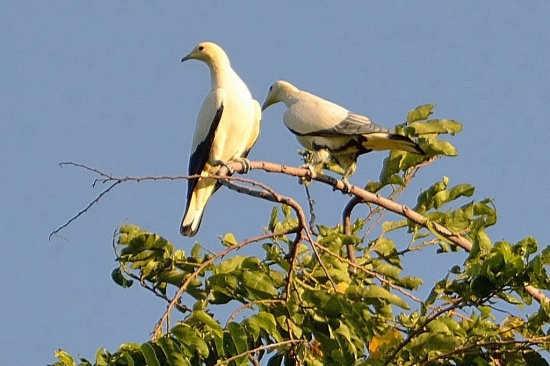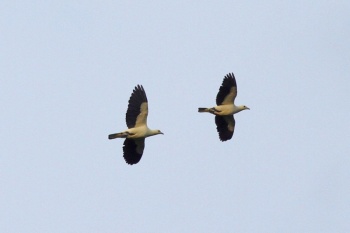m (White Imperial Pigeon moved to White Imperial-Pigeon) |
|||
| (11 intermediate revisions by 4 users not shown) | |||
| Line 1: | Line 1: | ||
| + | '''Alternative names: White Imperial Pigeon; White-tipped Imperial Pigeon; Celebes Pied Imperial Pigeon''' | ||
| + | [[Image:Ducula luctuosa 1024 3.jpg|thumb|550px|right|Photo by {{user|codexluminati|codexluminati}}<br />[[Tangkoko]], North [[Sulawesi]], [[Indonesia]], October 2014]] | ||
;[[:Category:Ducula|Ducula]] luctuosa | ;[[:Category:Ducula|Ducula]] luctuosa | ||
| − | |||
==Identification== | ==Identification== | ||
| − | + | 37-48 cm. | |
| + | * White plumage | ||
| + | * Silvery grey flight-feathers with black edges | ||
| + | * Black feathers in tibial and ventral regions, giving a mottled appearance | ||
| + | Sexes similar. Juveniles greyer and with buff feather fringes. | ||
| + | ====Similar species==== | ||
| + | [[Image:Silver-tipped Imperial Pigeon - Toraut.jpg|thumb|350px|right|Photo by {{user|WorldBirder99|Andy Livermore}}<br />Toraut, [[Sulawesi]], [[Indonesia]], October 2014]] | ||
| + | [[Pied Imperial Pigeon]] looks similar but has all black flight-feathers. | ||
==Distribution== | ==Distribution== | ||
| − | [[Sulawesi]] | + | Endemic to [[Sulawesi]] and some adjacent islands. South East Asia: [[Indonesia]]: [[Greater Sundas]]. A poorly known species, generally uncommon. |
| + | |||
==Taxonomy== | ==Taxonomy== | ||
| − | + | This is a [[Dictionary_M-O#M|monotypic]] species.<br /> | |
| + | Sometimes regarded as conspecific with [[Pied Imperial Pigeon]]. | ||
==Habitat== | ==Habitat== | ||
| − | Forests and mangroves. | + | Forests, cultivated areas and mangroves in lowlands up to 475 m.<br /> |
| + | Less restricted to coastal and small-island habitats than [[Pied Imperial Pigeon]]. | ||
==Behaviour== | ==Behaviour== | ||
| + | ====Diet==== | ||
| + | Feeds on fruits. No other published information but probably similar in diet to [[Pied Imperial Pigeon]].<br /> | ||
| + | Usually foraging in flocks of 5 to 20 birds. | ||
| + | ====Breeding==== | ||
| + | Breeding reported in September and October. | ||
| + | ====Movements==== | ||
| + | No information. | ||
| + | ==References== | ||
| + | #{{Ref-Clements6thAug14}}#{{Ref-GillDonsker14V4.4}}#Handbook of the Birds of the World Alive (retrieved November 2014) | ||
| + | {{ref}} | ||
==External Links== | ==External Links== | ||
{{GSearch|Ducula+luctuosa}} | {{GSearch|Ducula+luctuosa}} | ||
| − | + | ||
| − | [[Category:Birds | + | [[Category:Birds]] [[Category:Ducula]] |
Latest revision as of 09:09, 19 June 2023
Alternative names: White Imperial Pigeon; White-tipped Imperial Pigeon; Celebes Pied Imperial Pigeon
- Ducula luctuosa
Identification
37-48 cm.
- White plumage
- Silvery grey flight-feathers with black edges
- Black feathers in tibial and ventral regions, giving a mottled appearance
Sexes similar. Juveniles greyer and with buff feather fringes.
Similar species
Pied Imperial Pigeon looks similar but has all black flight-feathers.
Distribution
Endemic to Sulawesi and some adjacent islands. South East Asia: Indonesia: Greater Sundas. A poorly known species, generally uncommon.
Taxonomy
This is a monotypic species.
Sometimes regarded as conspecific with Pied Imperial Pigeon.
Habitat
Forests, cultivated areas and mangroves in lowlands up to 475 m.
Less restricted to coastal and small-island habitats than Pied Imperial Pigeon.
Behaviour
Diet
Feeds on fruits. No other published information but probably similar in diet to Pied Imperial Pigeon.
Usually foraging in flocks of 5 to 20 birds.
Breeding
Breeding reported in September and October.
Movements
No information.
References
- Clements, J. F., T. S. Schulenberg, M. J. Iliff, D. Roberson, T. A. Fredericks, B. L. Sullivan, and C. L. Wood. 2014. The eBird/Clements checklist of birds of the world: Version 6.9., with updates to August 2014. Downloaded from http://www.birds.cornell.edu/clementschecklist/download/
- Gill, F and D Donsker (Eds). 2014. IOC World Bird Names (version 4.4). Available at http://www.worldbirdnames.org/.
- Handbook of the Birds of the World Alive (retrieved November 2014)
Recommended Citation
- BirdForum Opus contributors. (2024) Silver-tipped Imperial Pigeon. In: BirdForum, the forum for wild birds and birding. Retrieved 6 June 2024 from https://www.birdforum.net/opus/Silver-tipped_Imperial_Pigeon





